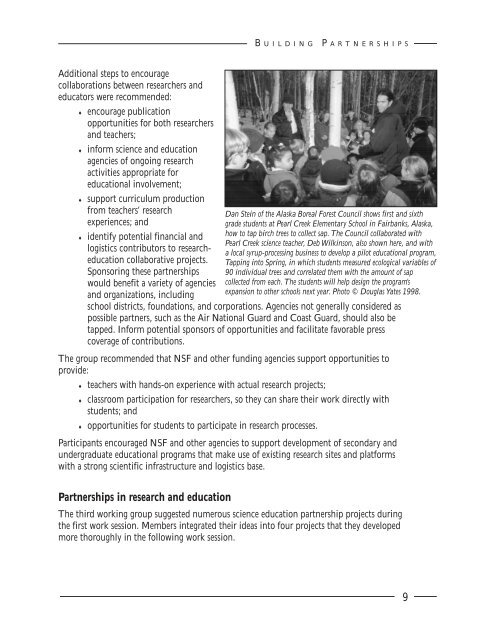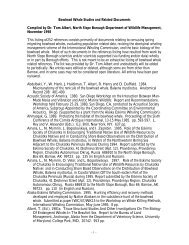ed report 4 page cover - Arctic Research Consortium of the United ...
ed report 4 page cover - Arctic Research Consortium of the United ...
ed report 4 page cover - Arctic Research Consortium of the United ...
You also want an ePaper? Increase the reach of your titles
YUMPU automatically turns print PDFs into web optimized ePapers that Google loves.
Additional steps to encourage<br />
collaborations between researchers and<br />
<strong>ed</strong>ucators were recommend<strong>ed</strong>:<br />
♦ encourage publication<br />
opportunities for both researchers<br />
and teachers;<br />
♦ inform science and <strong>ed</strong>ucation<br />
agencies <strong>of</strong> ongoing research<br />
activities appropriate for<br />
<strong>ed</strong>ucational involvement;<br />
♦ support curriculum production<br />
from teachers’ research<br />
experiences; and<br />
B U I L D I N G P A R T N E R S H I P S<br />
Dan Stein <strong>of</strong> <strong>the</strong> Alaska Boreal Forest Council shows first and sixth<br />
grade students at Pearl Creek Elementary School in Fairbanks, Alaska,<br />
how to tap birch trees to collect sap. The Council collaborat<strong>ed</strong> with<br />
Pearl Creek science teacher, Deb Wilkinson, also shown here, and with<br />
a local syrup-processing business to develop a pilot <strong>ed</strong>ucational program,<br />
Tapping into Spring, in which students measur<strong>ed</strong> ecological variables <strong>of</strong><br />
90 individual trees and correlat<strong>ed</strong> <strong>the</strong>m with <strong>the</strong> amount <strong>of</strong> sap<br />
collect<strong>ed</strong> from each. The students will help design <strong>the</strong> program’s<br />
expansion to o<strong>the</strong>r schools next year. Photo © Douglas Yates 1998.<br />
♦ identify potential financial and<br />
logistics contributors to research<strong>ed</strong>ucation<br />
collaborative projects.<br />
Sponsoring <strong>the</strong>se partnerships<br />
would benefit a variety <strong>of</strong> agencies<br />
and organizations, including<br />
school districts, foundations, and corporations. Agencies not generally consider<strong>ed</strong> as<br />
possible partners, such as <strong>the</strong> Air National Guard and Coast Guard, should also be<br />
tapp<strong>ed</strong>. Inform potential sponsors <strong>of</strong> opportunities and facilitate favorable press<br />
<strong>cover</strong>age <strong>of</strong> contributions.<br />
The group recommend<strong>ed</strong> that NSF and o<strong>the</strong>r funding agencies support opportunities to<br />
provide:<br />
♦ teachers with hands-on experience with actual research projects;<br />
♦ classroom participation for researchers, so <strong>the</strong>y can share <strong>the</strong>ir work directly with<br />
students; and<br />
♦ opportunities for students to participate in research processes.<br />
Participants encourag<strong>ed</strong> NSF and o<strong>the</strong>r agencies to support development <strong>of</strong> secondary and<br />
undergraduate <strong>ed</strong>ucational programs that make use <strong>of</strong> existing research sites and platforms<br />
with a strong scientific infrastructure and logistics base.<br />
Partnerships in research and <strong>ed</strong>ucation<br />
The third working group suggest<strong>ed</strong> numerous science <strong>ed</strong>ucation partnership projects during<br />
<strong>the</strong> first work session. Members integrat<strong>ed</strong> <strong>the</strong>ir ideas into four projects that <strong>the</strong>y develop<strong>ed</strong><br />
more thoroughly in <strong>the</strong> following work session.<br />
9




